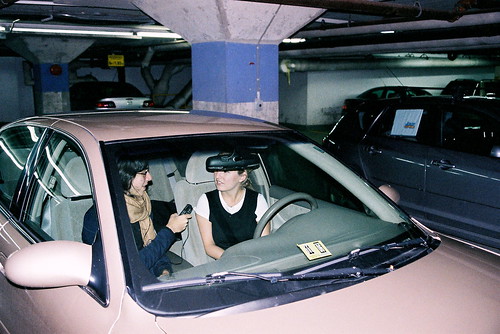
The seventh interview of The Impervious P-lot was with Allison Riddle, federal employee. We spoke with her because she regularly uses the sublevel parking of the grey government buildings in Hull. Sitting with us inside her car in the dark, fluorescent-lit lot, Riddle told us she takes the bus to work except on days when it’s rainy or snowy, when she’s slept in, or when she has errands to run or friends to meet after work. In those cases she’ll drive, which she tries not to do more than twice a week.
In answer to our question about whether or not she enjoys anything about parking, she said:
It’s all about convenience. It really is. I mean there’s guilt of spending money I shouldn’t be spending and there’s guilt of, frankly, polluting the environment by driving to work. It’s a guilty indulgence, I would say, because there are other ways for me to get to work. There are other ways for, I bet, a lot of people who drove today to get to work. They didn’t need to drive their own vehicle. It’s all about convenience.
Later Riddle told us that if the parking lot wasn’t so close to the building — wasn’t located inside the very building she works in — she probably would drive to work less frequently. This reminded me of what Marc Dubé said in our previous interview, about parking lots that don’t succeed because they’re too far away.
Although most of Riddle’s colleagues complain about cost of parking, cost doesn’t seem to be a factor in preventing them from driving; not even the inconvenience of purchasing a monthly parking pass (which apparently involves long early-morning queues) deters them from using their cars. This leads me to wonder, if there were fewer lots nearby the government buildings, would there be fewer people driving to work? Is accessibility to “convenient†parking the key to reducing the number of cars on the road?
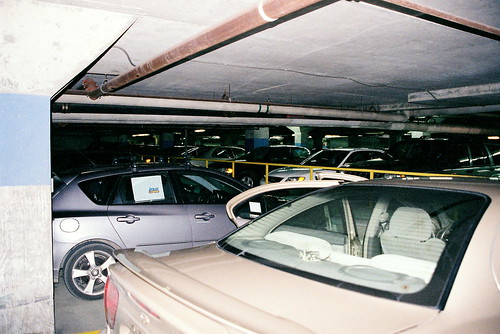
Of all that Riddle said during our interview with her, what made the greatest impression on me was her perception of Hull, which differs seriously from ours. The project The Impervious P-lot was initiated after a few of us moved to Hull for several months. We lived surrounded by parking lots. Riddle’s view is formed by her experience as a commuter. She and her colleagues line up to buy monthly parking passes, share tips on cheap lots, and drive around in circles to find an empty space. While The Impervious P-lot was inspired by the too high concentration of parking lots within a small area of Hull, Riddle thinks that “there’s very limited parking here.â€
Amber Yared is one among a group of artists, writers, educators, and architects working on The Impervious P-lot, a Hull-based CUP project about parking lots and what they do besides store cars. She will be posting her findings on the Spacing Wire as the project progresses.

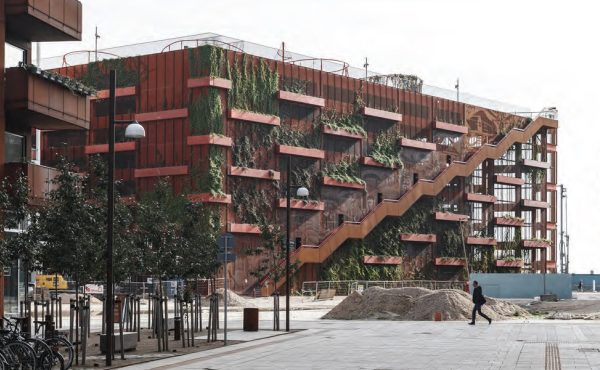
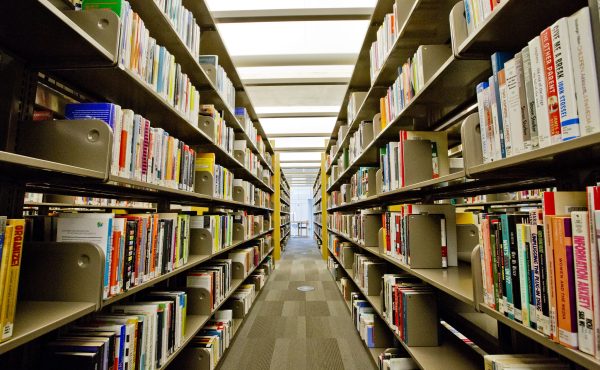
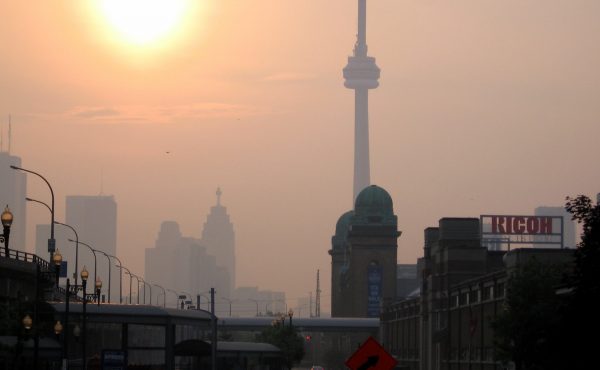
3 comments
What strikes a funny note is that, months later, you’re still musing about why it is that people drive as opposed to taking the bus. Why not focus on in that a bit more? There are thousands of civil servants around you. Ask them about how the car fits into their routine.
Do they have kids? Do they live in car-oriented suburbs? Are there things or people that need to be dropped off or picked up, before or after work? How heavily do those few minutes of in-car alone time weigh, when the civil servant is surrounded neither by cubicled co-workers nor family members (nor a packed bus), and has a few moments to herself? Is there a big difference between those coming from the Ontario side, where more effort has been put into public transit, and from the Quebec side, in which the Portage stops are part of the system? If transit means 20 more minutes (or 5, or 60) of commute time for a civil servant, what do those 20 (or 5, or 60) minutes come out of — time with children? Supper preparation? Groceries? Being on time to meet the school bus?
These are only the starting point. But it seems to me that, until you’ve gone down that road — and it is a long one — you’re going to have a hard time thinking about why parking space is preferable to public transit for most civil servants.
“Later Riddle told us that if the parking lot wasn’t so close to the building  wasn’t located inside the very building she works in  she probably would drive to work less frequently. […] Although most of Riddle’s colleagues complain about cost of parking, cost doesn’t seem to be a factor in preventing them from driving.”
I’ve done a little digging around recently on this issue in the GTA and found the following interesting stats for GTA employment areas:
Broader downtown area: 20% employees have free parking
Free parking: 61% drive; 29% transit
Pay parking: 17% drive; 70% transit
North York Centre: 40% free parking
Free parking: 77% drive; 15% transit
Pay parking: 53% drive; 30% transit
Scarborough Town Centre: 67% free parking
Free parking: 74% drive; 17% transit
Pay parking: 63% drive; 26% transit
Consumers Road area: 79% free parking
Free parking: 87% drive; 4% transit
Pay parking: 69% drive; 21% transit
Mississauga city centre: 78% free parking
Free parking: 82% drive, 9% transit
Pay parking: 72% drive, 15% transit
There is a similar pattern across the GTA. In areas with limited free parking, the sample size is lower leading to more margin for error, but the pattern is consistent nevertheless. Maybe things are different in Hull, but parking cost certainly is a factor in determining whether GTA workers drive to work or take transit (not as much of a factor in outlying areas with poorer transit service, but a factor nevertheless).
Great piece – hmmm, heated underground parking right under your place of work – no need even to wear a coat, really.
Saves time in the morning if you can go from your indoor garage at home to a workplace garage like that.
Essentially by making underground parking so prevalent, one of the things we are doing is allowing people to use a ton of steel and rubber as a winter coat – just a little hard on the environment!
If we survive as a species hopefully someone a hundred years from now can look back and be stunned by pictures like that one – like we are by those pics of those hunters blasting away the last of the Passenger Pigeons 80 years ago…